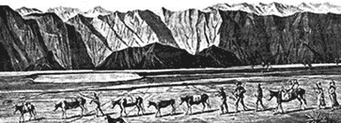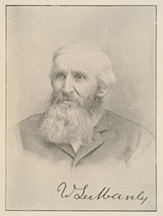Death Valley '49rs

In 1848, gold was discovered at Sutter's Mill in California and people from all over the United States packed their belongings and began to travel by wagon to what they hoped would be new and better life. Since most of these pioneers began their exodus to California in 1849, they are generally referred to as the California Gold Rush '49ers.
One group, later to be called the Death Valley '49ers, had heard about the Old Spanish Trail, a route that went around the south end of the Sierra Nevada and was safe to travel in the winter.
The group got into a dispute on which way to go. One group, the Bennett-Arcan party, wanted to head south, the other group, the Jayhawkers, wanted to stay with the original plan of traveling west.
The group eventually split and went their separate ways, but they both were to have two things in common. They were saved from dying of thirst by a snow storm and they ended up in Death Valley. They entered the valley by way of present day Death Valley Junction and along the same route followed by Highway 190. On Christmas Eve of 1849, some of them arrived at Travertine Springs, the source of Furnace Creek.
One group, later to be called the Death Valley '49ers, had heard about the Old Spanish Trail, a route that went around the south end of the Sierra Nevada and was safe to travel in the winter.
The group got into a dispute on which way to go. One group, the Bennett-Arcan party, wanted to head south, the other group, the Jayhawkers, wanted to stay with the original plan of traveling west.
The group eventually split and went their separate ways, but they both were to have two things in common. They were saved from dying of thirst by a snow storm and they ended up in Death Valley. They entered the valley by way of present day Death Valley Junction and along the same route followed by Highway 190. On Christmas Eve of 1849, some of them arrived at Travertine Springs, the source of Furnace Creek.
Manly & Rogers

From Furnace Creek, the routes of the two groups split again. The Jayhawkers went north toward the Mesquite Flat Sand Dunes. After crossing the Panamint Mountains via Towne Pass and dropping down into Panamint Valley, most of them turned south, making their way into Indian Wells Valley near the present day city of Ridgecrest. There they follow a prominent indian trail heading south to civilization.
Meanwhile, the Bennett-Arcan party struggled south across the salt flats of Death Valley, and attempted to pass over the Panamint Range, but were unable to do so. They retreated to the valley floor and sent two young men, William Lewis Manly and John Rogers, 'over the mountain' to get supplies.
Thinking the Panamint Range was the Sierra Nevada, some expected a speedy return. Instead, nearly a month went by as the men walked more than 300 miles to Mission San Fernando (present day Santa Clarita), got supplies at a ranch and traveled back with three horses and a one-eyed mule.
Meanwhile, the Bennett-Arcan party struggled south across the salt flats of Death Valley, and attempted to pass over the Panamint Range, but were unable to do so. They retreated to the valley floor and sent two young men, William Lewis Manly and John Rogers, 'over the mountain' to get supplies.
Thinking the Panamint Range was the Sierra Nevada, some expected a speedy return. Instead, nearly a month went by as the men walked more than 300 miles to Mission San Fernando (present day Santa Clarita), got supplies at a ranch and traveled back with three horses and a one-eyed mule.
How Death Valley got its name

When Manly and Rogers finally arrived to the camp of the Bennett-Arcan party they found many of the group had left to find their own way out of the valley. Two families with children had patiently remained, trusting the men to save them. Only one man had perished during their long wait, but as they made their way west over the mountains, some said to have proclaimed "Goodbye, Death Valley," giving the valley its morbid name.
Exactly what routes the emigrants took to escape Death Valley has been subject of much speculation by historians. Some say they visited watering holes of Desert Spring in Cantil, Willow Springs west of Rosamond, and Barrel Springs south of Palmdale. Others say, Manly and Rogers traveled over the the Panamints and down to Searles Lake Valley (Trona area),then passed present day Ridgecrest, then followed the route of today's Highway 14. One historian believes the duo crossed the El Paso Mountains through Last Chance Canyon. Then they went past Koehn Dry Lake in Fremont Valley, continuing south through present day California City, then Edwards Air Force Base, and down Soledad Canyon.
Regardless, no historian could deny the Death Valley '49rs incredible story of survival, fortitude, and their very own place in history.
Exactly what routes the emigrants took to escape Death Valley has been subject of much speculation by historians. Some say they visited watering holes of Desert Spring in Cantil, Willow Springs west of Rosamond, and Barrel Springs south of Palmdale. Others say, Manly and Rogers traveled over the the Panamints and down to Searles Lake Valley (Trona area),then passed present day Ridgecrest, then followed the route of today's Highway 14. One historian believes the duo crossed the El Paso Mountains through Last Chance Canyon. Then they went past Koehn Dry Lake in Fremont Valley, continuing south through present day California City, then Edwards Air Force Base, and down Soledad Canyon.
Regardless, no historian could deny the Death Valley '49rs incredible story of survival, fortitude, and their very own place in history.
